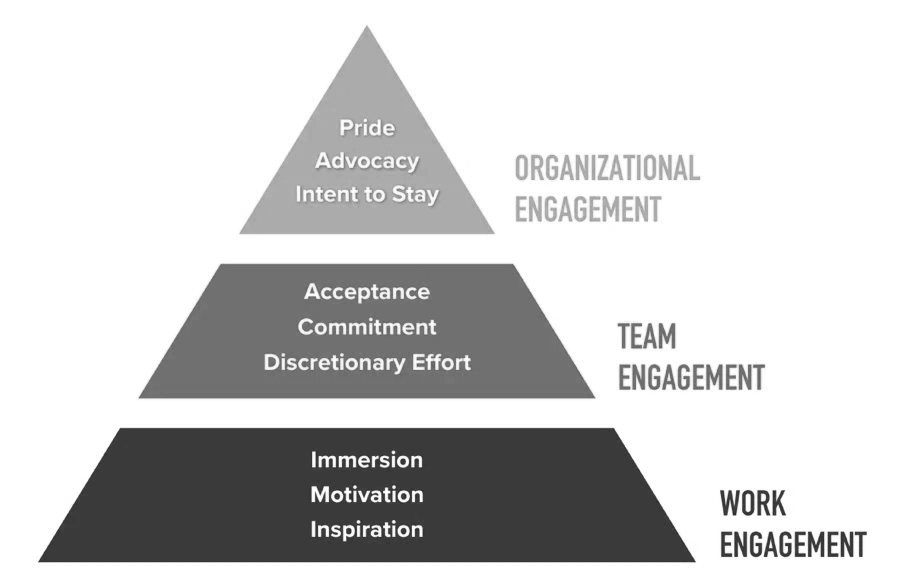The 3 Key Levels of Employee Engagement That Drive Performance and Retention
We define employee engagement as the strength of the mental and emotional connection employees feel toward their organization, their team, and their work. Those three levels of employee engagement can make or break your talent management strategy.
We know from organizational culture assessment research that emotionally invested employees typically display a higher degree of commitment and productivity than their less engaged peers. They contribute positively to the company culture because they are genuinely interested in their work and motivated to contribute to team and organizational success.
When doing research on employee listening, our experts found that employee engagement hinges on three factors that you should measure and act upon if you want to improve the levels of employee engagement in your organization:
- Work Engagement
How connected am I to the work I’m doing? - Team Engagement
How connected do I feel to my immediate coworkers? - Organizational Engagement
How connected am I to the organization as a whole?
Categories of Employee Engagement
Based on their perceptions of their workplace, employees are categorized into four main groups:
- Highly Engaged Employees
Highly engaged employees hold very favorable opinions of their workplace. These “brand advocates” speak highly of their company to family and friends. They encourage other employees around them to do their best. - Moderately Engaged Employees
Moderately engaged employees see their organization in a moderately favorable light. They like their company, but something about the organization, their team, or their job that holds them back from being fully engaged. These employees are less likely to ask for more responsibilities and may underperform. - Barely Engaged Employees
Barely engaged employees feel indifferent toward their place of employment. They usually lack motivation for their position and will only do as little as possible to just get by. Barely engaged employees may be researching other jobs and are a high turnover risk. - Disengaged Employees
Disengaged employees have a negative opinion of their place of work. They are disconnected from the mission, goals, and future of the organization. They lack commitment to their position and responsibilities. It’s important to understand how to handle disengaged employees so that their negative perceptions don’t impact the productivity of employees around them.
What Doesn’t Define Employee Engagement
Employee engagement is often used interchangeably with similar concepts like employee happiness, satisfaction, or wellbeing. But we know from project postmortem data that there are some clear differences among these concepts that are important to understand:
- Employee Engagement Is Not Employee Happiness
Some leaders may wonder how to keep employees happy. While important, happiness is different from engagement. It says nothing about how invested employees are in the company, nor how hard they’re working on behalf of the organization’s mission.
Happiness is a short-term, rapidly changing measurement. For example, an employee may feel temporary happiness from a raise and then sink back into disengagement. Employee engagement is a deep, long-term connection to the organization. - Employee Engagement Is Not Employee Satisfaction
Employee satisfaction can only be measured at surface level. An employee who is satisfied may not be engaged. Generally speaking, satisfied employees will not take steps to go above and beyond.
They usually stick around, but they aren’t driven to go the extra mile. Engaged employees are productive, while satisfied employees tend to coast through their work and experience. - Employee Engagement Is Not Employee Wellbeing
Employee wellbeing evaluates many areas of an employee’s life, such as how well they cope with stress or if they’re fulfilling their potential. Providing resources to increase employee wellbeing can increase employee engagement. Employee engagement focuses on an employee’s connection with their company—not on their own wellbeing.
The Bottom Line
Employee engagement is not about keeping people superficially happy, satisfied, or well-adjusted. It is about cultivating a deep, sustained connection to their work, their team, and their organization. When leaders measure and act on the three key levels of engagement, they can move employees from indifference to advocacy and build a workforce that is both committed and productive.
To learn more about the 3 key levels of employee engagement, download The Top 6 Forces Driving Employee Engagement and Strategies to Move the Engagement Needle


Recent Comments